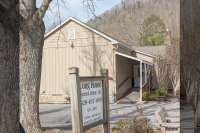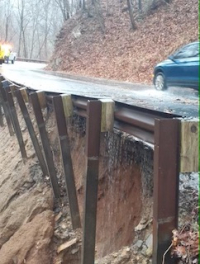WCU students practice ancient metalsmithing techniques
 What sounded like a jet engine echoed out of the building tucked away on the hill.
What sounded like a jet engine echoed out of the building tucked away on the hill.
Peering into the large bay doors of the metal studio at the Jackson County Green Energy Park in Dillsboro, the booming noise is coming from a foundry in the corner that was used to turn metals into molten liquid for casting.
And this past Monday, students from the art department at Western Carolina University took part in casting bronze and aluminum with their recently constructed plaster molds.
“It’s surprising how thin the molten metal gets,” said Timm Muth, director of the Jackson County Green Energy Park. “It pours out like Kool-Aid when I was expecting it to be like honey. It comes out quick and makes it a little scary.”
Fueled by methane from a closed landfill next door, the foundry is known as the only one of its kind in the world to run entirely on the sustainable gas. The highly flammable product produces a large flame that shoots out of the small opening at the top of the barrel. With temperatures hovering around 2,200 degrees, the high level of heat is needed to properly melt down the bronze (melting point of 1,742 degrees) and aluminum (melting point of 1,220 degrees).
Partnering with the school for the last few years, the park offers the WCU students a state-of-the-art facility that can be accessed for a nominal fee. The cooperation also benefits the Green Energy Park, says Muth.
Related Items
“It gives them a place to go off campus to focus on what they’re doing,” he said “They can actually make it part of their curriculum without having to make their own facility, and we have the safety taken care of here.”
Led by Marya Roland, associate professor of art at WCU, a dozen students have spent the last two weeks constructing their molds.
“I think they’re really excited,” she said. “The ones that have had experience doing this kind of know what to expect. The others won’t really understand the process until you do it. You don’t understand what the wax/metal casting process is all about until you do it. There are so many different levels.”
The class starts by shaping wax into whatever design the students have in mind, which ranges from a fishing hook to figurines to a part for a screen door. After they carve out their shape, they surround the wax with plaster and sand. Once the plaster hardens, they melt out the wax until just the mold remains. From there, they take the molten metal and pour it gently into the mold, wait for it to solidify, crack open the plaster and expose their finished piece to the world.
“It’s like Christmas because you have wait to crack open the molds,” Roland said. “If you open it before then, it’s like a cake and will fall down. It’s as much work as it’s fun.”
Roland pointed out that the steps involved have to be choreographed beforehand to ensure precision and care is given to the process.
“You can read about it online or in art history, but I don’t think you’ll really understand it until you participate,” she said. “It’s very complex, and each step has to be technically perfect or you’ll fail at the end.”
A technique thousands of years old, casting metal is at the very foundation of what has led to the achievements of a 21st century society. Though the process has remained largely unchanged for centuries, its importance and relevance to the innovation of mankind can never be understated.
“If there’s no metal work, there’s no modern technology,” Muth said.
Asking for volunteers to make up teams needed to pull the top off the barrel, take the crucible (containing the molten metal) out of the barrel, place the crucible down gently and hoist it up to pour slowly into the molds, Muth carefully instructs the students with a couple of trial runs. Once they get the concept, they strap on steel-toed boots, leather chaps and protective face/body gear to take proper precautions and avoid injury.
“It needs to be well coordinated because you’re dealing with some pretty dangerous stuff here. You can’t just set things down anywhere,” he said. “It’s got to be set down in a special position, picked up and moved around with certain tools. That’s one of the things we can do at the park because it’s inside of this building and you can control what goes on.”
Carefully lifting up the molten liquid up and over the molds, the students help each other out, making sure those pouring are level, in line, and are tipping the crucible at the ideal pace. Once each mold is filled and the crucible lowered back into the foundry, there is a momentary silence. Muth gives the signal that all is well. The crew claps and cheers at their success.
One of the students in charge of pouring, senior Amanda Humes is finishing up a degree in sculpture. She has aspirations to make her passion into a career, and being part of the process today is another small step in that direction. Her mold is of three connected figurines and she’s eager to crack open the plaster.
“It’s not as scary as it seems, but it’s hot. Bronze is quite a bit hotter than aluminum and it’s very heavy,” she said. “I just love getting my hands dirty and I love bronze, so the outcome is worth it for me.”
Helping move the lid on the barrel, senior studio art major Ian Michaels appreciates the benefits of using green energy as fuel to create projects that normally would use toxic materials.
“This is a great example of recycling what we have and applying it in a positive direction,” he said. “I like the adapting of a methane heating system. It’s very progressive, something I can take part in and encourage.”
With the molten metal spending the next several hours solidifying, the class will be smashing open the plaster in the coming days. They’re all looking forward to it, especially Roland, who after years of being involved in the process is still taken back by the aura and grandeur of casting.
“For me, and I think for the students, it’s about hooking up with history,” she said. “If you look at some of the images of statues from the Renaissance, it’s unbelievable. It’s very intense, and you when you finish it, you know you’ve been through something.”









